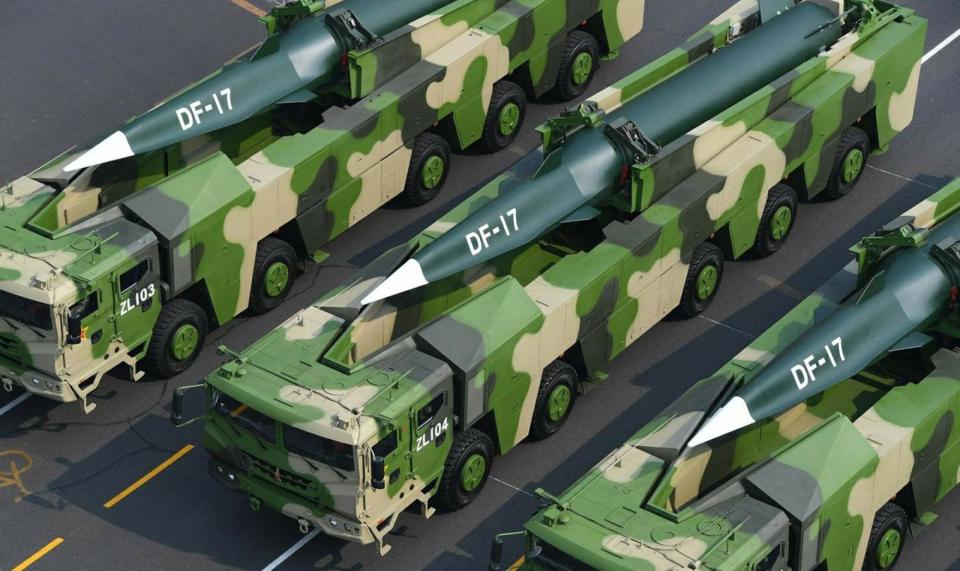US must pick up hypersonic arms pace to meet competition: defence contractor
Washington cannot "lag behind" in the development of hypersonic weapons and is ready to support its partners' air defence capabilities, according to a leading US defence contractor.
Bridget Slayen, a senior communicator at Northrop Grumman's international programme, said "threats all around the world" were generating interest among European and Asia-Pacific partners in the company's air defence and missile products.
Speaking at the Eurosatory defence exhibition in Paris on Tuesday, Slayen did not directly refer to China or Russia but said, "if another country [has] hypersonic missiles ... we would want to [make] sure we have the best we can for deterrence factors".
"We don't want to be lagging behind," she said.
Northrop Grumman is contributing to Washington's Hypersonic Attack Cruise Missile (HACM) - an air-breathing, scramjet-powered cruise missile that can fly at speeds greater than Mach 5.
Washington is in competition with its geopolitical rivals China and Russia - the only two other countries with hypersonic weapon-equipped militaries - to build up stocks of missiles based on the technology.
Northrop Grumman is responsible for providing a scramjet for the HACM programme, launched in 2022. The US Air Force aims to field the weapon by 2027 and is working to "mature" the missile to enable flight test activities by financial year 2025.
According to its 2025 financial year budget request in March, the Pentagon has allocated US$517 million for the HACM, as well as a projected total R&D spending of roughly US$2.4 billion through to the 2029 financial year.
Beijing's DF-17 is a medium-range missile system equipped with a hypersonic glide vehicle (HGV) that has been in operation since 2019.
With a range of 1,600km (1,000 miles), a Pentagon report in 2022 described the DF-17's "primary purpose" as "striking foreign military bases and fleets in the Western Pacific".

Beijing's DF-17 is a medium-range missile system equipped with a hypersonic glide vehicle. Photo: Weibo alt=Beijing's DF-17 is a medium-range missile system equipped with a hypersonic glide vehicle. Photo: Weibo>
China is also developing a 3,000km (1,860-mile) range air-launched ballistic missile version of the DF-21, the CH-AS-X-13, which will be carried by an H-6K bomber and is projected to be in service next year.
In Ukraine, Russia reportedly used its Kh-47M2 Kinzhal hypersonic air-launched, nuclear-capable ballistic missiles in March 2022, a month after it launched its invasion.
The exchange of missile attacks between Moscow and Kyiv, along with the tensions in the Taiwan Strait and the South China Sea, is fuelling demand for defence systems in Europe and the Asia-Pacific region from major arms exporters, including the US and China.
Air and missile defence systems were among the core interests at this year's Eurosatory, which has increasingly emphasised modern warfare, especially since the Russian invasion of Ukraine in February 2022.
Northrop Grumman was showcasing its latest Integrated Battle Command System (IBCS), designed as a single integrated architecture that links radars across thousands of miles and is capable of shooting down short, medium, and intermediate ballistic missiles in their terminal phase.
Dubbed a "game changer" for its speeding up of decision-making processes, the IBCS was approved for full-rate production in April last year with the first one delivered to the US Army this month.
"There's [demand from] the countries that are adding in their defence spending bill that they are wanting to modernise or acquire an integrated air missile defence system," Slayen said.
"And we're proposing our product to see if that meets their needs. If you're an island country, you want it to defend your land."

The Northrop Grumman booth at the Eurosatory exhibition in Paris. Photo: Seong Hyeon Choi alt=The Northrop Grumman booth at the Eurosatory exhibition in Paris. Photo: Seong Hyeon Choi>
In February, Poland bought an IBCS system, while Serbia took delivery in 2022 of a China-made FK-3 surface-to-air defence system, an export variant of the HQ-22 ordered in 2019.
US aviation giant Lockheed Martin faced sanctions from Beijing after its US$100 million arms deal with Taipei in February 2022 that included upgrades to the self-ruled island's Patriot missile defence system.
Beijing regards Taiwan as part of its territory, to be reunited with the mainland by force if necessary. The US, like most countries, does not recognise Taipei but is committed to providing arms for the island's defence.
At its Eurosatory booth, Northrop Grumman - also sanctioned by Beijing for selling weapons to Taiwan - had its advanced anti-radiation guided missile extended range (AARGM-ER) on display.
According to Slayen, the air-launched AARGM-ER is suitable for militaries operating US fighter jets, such as F-35s or F-16s, for the "suppression and destruction of enemy air defence".
In May, Chinese defence ministry spokesman Senior Colonel Wu Qian criticised the US deployment of Lockheed's Typhon missile system in its annual Balikatan joint exercise with the Philippines for bringing "huge risks of war into the region".
This article originally appeared in the South China Morning Post (SCMP), the most authoritative voice reporting on China and Asia for more than a century. For more SCMP stories, please explore the SCMP app or visit the SCMP's Facebook and Twitter pages. Copyright © 2024 South China Morning Post Publishers Ltd. All rights reserved.
Copyright (c) 2024. South China Morning Post Publishers Ltd. All rights reserved.

 Yahoo Finance
Yahoo Finance 